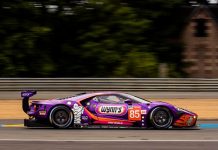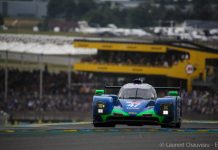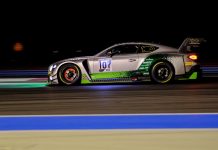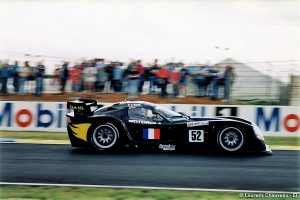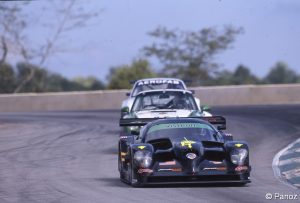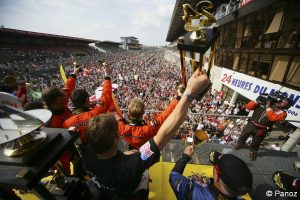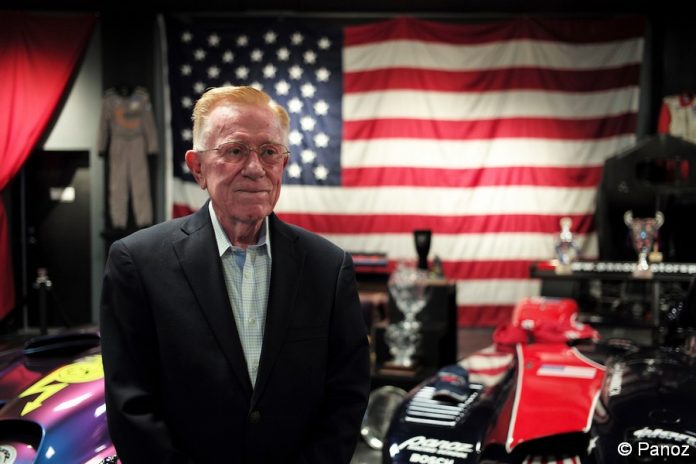
Our section dedicated to the Club des Pilotes des 24 Heures du Mans does not give the floor today to a driver, but to a manufacturer, Don Panoz.
Don Panoz is since these last twenty years a key figure of motorsport and endurance. By founding the American Le Mans Series in 1997 he was a major contributor to the convergence between the Automobile Club de l’Ouest -and Le Mans-(with Jean-Claude Plassart, former ACO President, below)
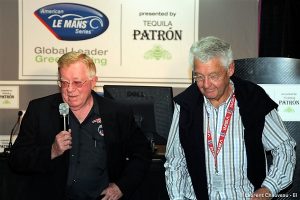 with North America, bringing back the Europena manufacturers to the USA. He also created the Petit Le Mans in 1998 on the Road Atlanta track, in Georgia.
with North America, bringing back the Europena manufacturers to the USA. He also created the Petit Le Mans in 1998 on the Road Atlanta track, in Georgia.
He has been successful too in many areas, such as the pharmaceutical sector, before involving himself in motorsport -and during this period as well- (he formed Mylan, with the first transdermal patch against tobacco, then Elan Coporation, founded in Ireland in 1969, with researches on the Alzheimer and neurodegenerative diseases), in the viticulture area (Chateau Ellan Winery & Resort) and in many other companies, with of course, more specifically for us : Elan technologies which has produced the Roadster Panozes, the Esperante, the famous DeltaWing, the Avezzano -currently racing in the Pirelli World Challenge, below- and the electric GT-EV built by par Green4U Technologies, an electric GT that we maybe will be racing at Le Mans some day.
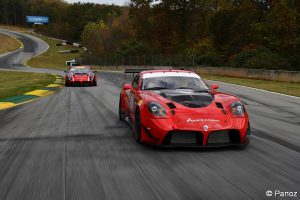 Don Panoz has kindly agreed to answer a few questions :
Don Panoz has kindly agreed to answer a few questions :
Did Le Mans mean anything to you?
No, it didn’t. As we go through this you’ll find out it wasn’t until I first went there in 1997 that I developed the infection of Le Mans.
When did you come for the first time at Le Mans ? What have been your feelings about it then and what do you think about Le Mans now ?
As I said, ’97 was my first trip with the Panoz GTR1 and to be accurate that was only the 7th race I’d ever been to in my life, and I got there, I was brand new to racing. I’d never had an interest until ’97 and I talked to my son and said he needed a racing heritage. He told me to mind my own business because he was too busy designing sports cars, and that since I was retiring from the Elan Corporation then I should do the racing, and bingo, there I was, I got infected by the Le Mans bug.
 What made you decide to get involved in motorsport racing and why did you chose sportscars and GT racing, and not single seaters, NASCAR or something else ?
What made you decide to get involved in motorsport racing and why did you chose sportscars and GT racing, and not single seaters, NASCAR or something else ?
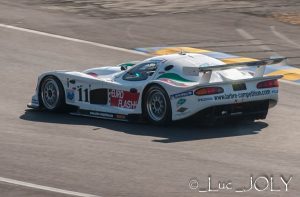 Well, I thought first of all singleseaters don’t really represent the Why did you chose sportscars and GT racing, and not single seaters, NASCAR or something else ?cars everybody drives every day. Sports cars do represent cars that consumers can drive every day, and sports cars generally are developing new foundations and technology and performance, aerodynamics, engine development etc., etc. because it’s a competitive situation and to be competitive you have to prove things and in proving things you increase performance and to me I find that quite attractive.
Well, I thought first of all singleseaters don’t really represent the Why did you chose sportscars and GT racing, and not single seaters, NASCAR or something else ?cars everybody drives every day. Sports cars do represent cars that consumers can drive every day, and sports cars generally are developing new foundations and technology and performance, aerodynamics, engine development etc., etc. because it’s a competitive situation and to be competitive you have to prove things and in proving things you increase performance and to me I find that quite attractive.
We did do singleseaters but that was after we got into racing and when I decided I didn’t need to keep going to Europe to buy technology to buy products, I decided to build our facilities here, and then we took our skills that we learned in engine development and carbon fibre and started building a whole range of sports cars including singleseaters.
Yeah, we won Indycars 4 times in 6 years. I was not a motorsport expert, I don’t want people to be confused. What I found was, I found that I got to be enthusiastic about it, because I was what they called a newcomer to the sport. I was 62 years old when I got into it.
I wasn’t looking like everybody else in racing up and down the pit-lane, the politics and so forth, I was looking across the track at what the fans were saying, at what they wanted and they really want us to build a uniformity, and they want to predict that people who perform the best, created the best, will win. And that’s quite contrary to some of the structures today – which Balance of Performance to me is a kind of socialism of racing – spend money, go fast and get penalised, spend nothing and get rewarded and compete.
You have been first to enter an hybrid car at Le Mans, the Panoz Esperante GTR-1 Q9 . Why did you stop this technology ?
In 1997 when I went to Le Mans for the first time with the GTR1 car, which by the way the GTR1 car was the first in some years to have a front engine as a prototype with a front engine, (?!!) and while I was there I met an interesting character Bill Gibson, who had a company called Zytek, which produced motors, and he was talking about doing an electric motor. And, potentially, he explained to me what a hybrid car could be, and I was enchanted with what he told me and I said “Yeah, I think we could do that” and we used our GTR1 car and built a hybrid car with nickel metal hydride batteries which we worked out with Varta out of Germany and got all excited and went to Le Mans and we missed qualifying by a second or so, I think, but we were stupid, we didn’t understand that we could have taken out battery weight for the qualifying sessions, but then we went on and raced it at Petit Le Mans and won.
And when it won I was ecstatic, I thought this is really the new frontier in technology and I went round to see all the major OEMs and I talked to them all, this is 20 years ago in 1998 and I said we are sure that it is efficient, we’re sure that it could save money etc etc., and I had this glassy stare back from everybody that kinda said “we’re not interested in hybrids” Isn’t that strange, because today they’d give you their right arm for the right hybrid car.
As for you, what have been the best Le Mans successes for Panoz ? The LNT Panoz Esperante GT2 win or the top finishes of the prototypes ?
I have to say that the LNT was the most exciting team because it was a privateer team from England and Lawrence Tomlinson who owned the team like a lot of privateer teams was a gentleman driver, and in fact was a number of seconds slower than Richard Dean who was a driver and Tom Kimber-Smith. And to watch the strategy, which I had a little to do with, of setting up for the race, and what we would do and how we would manage the race, and to watch them hit all that, right on the numbers, and with a gentleman driver in the team, and go on and beat the factory Porsches and the factory Ferraris I thought was just outstanding. And I just have to say as a little bit, there was a chap walking down by the grid after the race was over and he stopped me and said “You’re Don Panoz, it’s a good thing that Patrick had a problem or you wouldn’t have won the race, and Porsche would have won.” The guy had a big Porsche shirt on and a Porsche cap and I looked at him and I said “But what about the six or seven other Porsches in the race?” And that was a moment of comeback that I really enjoyed.
I think that’s true, and one of the things that was most impressive was that for a number of years , I forget exactly how many, five or six years we were voted the fan favorites at Le Mans, and I think it had to do with the fact that our cars were a little bit different, the fact that they were front engined and the fact that we really in this period of time in the prototypes we were racing with a Ford small block, normally aspirated engine , and were competitive. And according to all the experts we had the engine in the wrong place, we had it up front. But I think it was the noise of that engine, it was the sound, it was the look of the car, it was the fact that we were an outsider, the underdog, I think that is what really gave us our momentum and our fame in Europe.
What is you greatest regret at Le Mans, if any ?
My greatest regret was that in 2005 which was the first year that we raced the Esperante, and I’d always talk to our guys, that at Le Mans it’s a 24hour race, and of course starting in the race and for the drivers there’s the pomp and circumstance, all of the hoop-la about Le Mans, its history and the drivers get – of course we all know they’re aggressive but they seem to get this little more adrenalin in them, and I kept talking to the guys and say ‘Look guys, it’s a 24hour race, all we want is to keep out of trouble, don’t pass in the corners, don’t hit the kerb, try not to get more than one lap behind, let other people make the mistakes, let their adrenalin carry them away and we’ll pick up during the night, when that V8 engine loves that cold air and we can do good. And in 2005, we made our speech, we started 5th on the grid and by the end of the first lap we were in 1st place and then of course we hit something and knocked the front end off the car. We were all excited, they brought it back, they put it in the garage, they got it fixed properly and by all accounts we had a car that should have won that year. But it was the next year with LNT that we employed those strategies and that’s how the car won.
Many famous drivers have driven Panozes at Le Mans, such as Andy Wallace, David Brabham, Jan Magnussen, Max Angelelli, Mario Andretti (Mario, below), Olivier Beretta, Max Papis, to name a few. Which ones did you impress most ?
I think that’s a really good question, and of course people like David Brabham, Jan Magnussen and Max and you can’t ignore Mario Andretti but the fact is we had drivers that were very impressive.
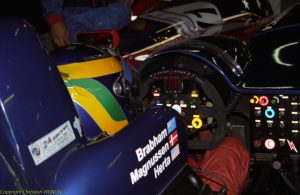 I think that David Brabham was one of the best strategists, I think that if you wanted to gain a lap and you needed it then Jan Magnussen was the kind of guy that could do that. But I was also looking around the field and I was also impressed with other drivers. JJ Lehto I thought was one of the best drivers in traffic that I’ve ever seen, the Scotsman for Audi, yeah, McNish, again a guy that could help you with gaining a lap, I think that we were so fortunate to have the range of drivers that we had and in 2006 at Le Mans which was the year I was appointed the recognition ‘Spirit of Le Mans’ award, that year I was thinking back over our ten years and to celebrate our tenth year and I was looking through the drivers list that year at Le Mans, and in that list that year there were over thirty drivers driving that year who had driven in Panoz cars.
I think that David Brabham was one of the best strategists, I think that if you wanted to gain a lap and you needed it then Jan Magnussen was the kind of guy that could do that. But I was also looking around the field and I was also impressed with other drivers. JJ Lehto I thought was one of the best drivers in traffic that I’ve ever seen, the Scotsman for Audi, yeah, McNish, again a guy that could help you with gaining a lap, I think that we were so fortunate to have the range of drivers that we had and in 2006 at Le Mans which was the year I was appointed the recognition ‘Spirit of Le Mans’ award, that year I was thinking back over our ten years and to celebrate our tenth year and I was looking through the drivers list that year at Le Mans, and in that list that year there were over thirty drivers driving that year who had driven in Panoz cars.
You use to say something like ”I don’t want to do what others have already done” . Is it your personal motto. Is it the reason why you have developped the DeltaWing ? Have you been pleased by the car results or did you expect more about it ?
Well, first of all, I do have that theory, I don’t see why I should spend my time all day doing what other people have done. Yes, something is exciting, a challenge, a feeling of accomplishment, that all occurs when you do things well. I say you need to take time to dream, and you need to make your dreams come true. But you also have to recognize that the more you dream, you will have the occasional nightmare!
About the Deltawing, it was so radical and everybody said it wouldn’t work, which was the challenge. All the experts, engineers, automobile companies said ‘no, no, no, no. This won’t work.’ It was Chip Ganassi who came up with the ideas and we tried to get it accepted as an Indycar, which of course it was turned down. But, the challenge was to prove that the car with half the horsepower could go just as fast as the other prototypes. And that was due to its unusual design, fulcrum effect and aerodynamics. We have actually produced a version as a 5seat road car, we’re looking at that, and think it’s like other things in the market, it’s kinda like Sparky our hybrid car, maybe we’re a little bit ahead of our time, but we have it in the suitcase, we have cars there and we’re going to bring them out and I think that there is a place for that car to continue and to show people that they can perform well and they can save money and it can be very safe as a family car.
You have started a new project, the Green4U Racing GT-EV, which you have presented last June at Le Mans ? How is the development progressing ? Will you submit and entry for the Garage 56 for Le Mans 2018 ?
OK, well, first of all it’s an exciting opportunity, because the challenge is really there. When you stop and think about what’s out there currently in the form of sportscars. Take a Ferrari, take a Porsche, whatever, and you fill them up with petrol, you’re going to go 250 to 300 miles. And when you look at Le Mans that amount of fuel and energy only lasts 55minutes, whereas a full tank in a regular car could last for 5 or 6 hours. And to get the efficiency of electric energy to be able to have a car that can perform competitively it is a big challenge. I call it the Holy Grail. To me, the Holy Grail is to be able to perform with an electric car and to replace the batteries as quick as they can fuel a car in the other sportscars and to be able to be as competitive I think is a hell of an accomplishment. Where are we? We keep working on it, the reason we keep working on it is because we haven’t hit any dead ends that tells us we can’t and that’s the challenge, is to improve it we have to find maybe another couple of laps but we’re working on that and of course there’s new technologies coming. It might not be 18 (2018), it could be 19 (2019), but we’re going to be incorporating all the latest technologies and we’re going to try to go to Le Mans and prove that an EVGT could win. The thing I like about it is again we are unusual, it’s a GT car and if we are successful with it we will market it. The driver and passenger two seats are not sitting side by side but in front to back like in a F16 cockpit, we’re talking about new technology head up display surround and vision etc etc plus, the Holy Grail of performance. We’ll keep working on it, like I said, we haven’ hit any roadblocks yet, but we still have some work to do.
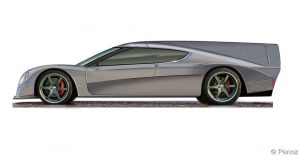 You have been successful in many areas, with Elan Corporation in the pharmaceutics area, Chateau Elan Winery & Resort, Panoz, LLC, Panoz Motorsports,the foundation of tthe American Le Mans Series, of Petit Le Mans , among others…Which one are you particularly proud of it, or are they all at the same level ?
You have been successful in many areas, with Elan Corporation in the pharmaceutics area, Chateau Elan Winery & Resort, Panoz, LLC, Panoz Motorsports,the foundation of tthe American Le Mans Series, of Petit Le Mans , among others…Which one are you particularly proud of it, or are they all at the same level ?
At the end of the day, being successful makes them on the same level. But they each had their own appeal and motivation, because they are different types of businesses, motivation point again accepting the challenge to try to do something better. In the pharmaceutical side there was developing technology that could reduce the dosage of drugs and reduce side effects. On the winery side it was making wine in Georgia which was generally considered that you couldn’t do. In race cars, and racing, it was that you can’t as a small group using even smaller technology like the Ford small block engine and show that you could beat people like Audi and BMW with all their turbocharging and fuel injection stuff – that was an accomplishment. Each one in its own way was gratifying. I think as i say, the Holy Grail which is going to be my last to roar. I’ll take a little more gratification but then that will be enough!
 Well that’s great, and listen, to be quite honest, i love people giving me the compliment because it fortifies that drive to try to do things differently and accomplish them. Of course, if you didn’t get any of that, it would discourage you and I want to thank all of the fans and all of the people out there for continuing to encourage me to try to do something a little bit better.
Well that’s great, and listen, to be quite honest, i love people giving me the compliment because it fortifies that drive to try to do things differently and accomplish them. Of course, if you didn’t get any of that, it would discourage you and I want to thank all of the fans and all of the people out there for continuing to encourage me to try to do something a little bit better.
We warmly thank Mr Don Panoz for his kindness. We thank too Laurent Chauveau, Luc Joly, Christian Vignon and Panoz for the pictures and also Gary Fong and Ray Toombs for their help.
More pictures here



